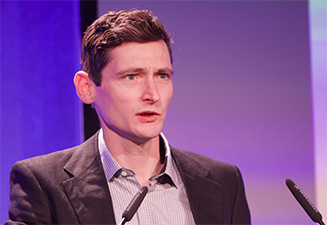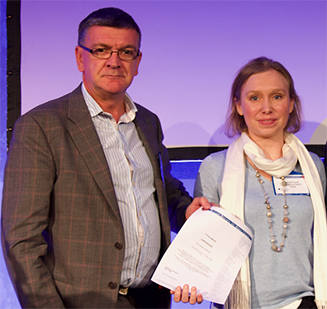The recent British Society for Heart Failure (BSH) 20th Annual Autumn Meeting took as its theme ‘Three decades of heart failure’. Commemorating the 30th anniversary of the landmark CONSENSUS trial and celebrating the quantum leaps in heart failure management that followed, the meeting was held on 23rd–24th November 2017 in London. Dr Simon Beggs reports some of the highlights.
30 years of heart failure
Professor Theresa McDonagh (King’s College Hospital, London) opened this session with a ‘tour de force’ exposition on the development of clinical biomarkers in heart failure from bench to bedside, focussing specifically on the natriuretic peptide family. This remarkable story began with the discovery of atrial natriuretic peptide (ANP) in 1981, which was determined to be natriuretic after observation of its diuretic effect following experimental injection into rodents. Brain natriuretic peptide (BNP) was subsequently discovered in porcine cerebrum and thereafter found to predominantly derive from myocardium in humans. With incremental research triumphs, the family of natriuretic peptides expanded, to include in time, C-type natriuretic peptide (CNP) and urodilatin.
Preclinical studies determined that natriuretic peptides encouraged vasodilation and antagonised the deleterious effects of the renin-angiotensin-aldosterone system, before the clinical utility of BNP and its parallel moiety, NT-proBNP, were examined in a number of landmark studies. The Hillingdon Heart Failure Study1 confirmed the high negative predictive value of a normal BNP/NT-proBNP assessment for excluding heart failure in dyspnoeic patients referred from primary care. The discriminatory utility of BNP to exclude heart failure in a population presenting acutely with undifferentiated dyspnoea was then demonstrated in the Breathing Not Properly Multinational Study.2 In parallel, the value of BNP as a tool for prognostication in heart failure was emerging.3 Thus today, natriuretic peptides are part of the diagnostic gold standard for heart failure. They provide prognostic guidance for heart failure clinicians and are, in many cases, utilised as part of the entry criteria for major clinical trials.4
Professor McDonagh’s prediction was that no emerging biomarker is likely to surpass the vital importance of natriuretic peptides in heart failure research and care, but that multi-marker strategies, involving the integration of novel molecules such as galectin and ST2, might eventually advance the field yet further.
Modern management of the right heart
Professor David Kiely (Royal Hallamshire Hospital, Sheffield) led the audience through the modern investigation and management of pulmonary hypertension (PH). The aetiology of PH is heterogeneous; delineation of the underlying cause is clinically meaningful, because defined treatments exist for pulmonary arterial hypertension (PAH) and chronic thromboembolic pulmonary hypertension (CTEPH). The optimal therapeutic strategy is less clear, however, for PH secondary to left heart pathology, pulmonary disease or uncertain aetiology.
A diagnosis of PH is usually arrived at through systematic assessment of patients presenting with undifferentiated breathlessness, and by screening high-risk groups. The chest radiograph, pulmonary function tests and ECG are common first-line investigations, but echocardiography is the most useful non-invasive tool in the initial assessment of suspected PH. Echocardiographic signs of possible PH include right atrial and ventricular dilatation, impaired right ventricular function, paradoxical septal motion and a notched envelope on Doppler assessment of pulmonary arterial flow. Importantly, an elevated systolic pulmonary artery pressure (PAP) on echocardiography suggests that mean PAP will be raised on right heart catheterisation but this latter investigation remains mandatory to secure the diagnosis. A raft of other investigations may subsequently be performed, including high resolution chest CT, lung perfusion imaging, cardiac magnetic resonance imaging (MRI), overnight oximetry and exercise testing, with the objective being to determine the pathology underlying PH. Navigating the maze of possible aetiologies is challenging, and it is prudent to seek specialist advice when diagnostic doubt exists: for example, it is sometimes mistakenly believed that a ‘negative’ CT pulmonary angiogram excludes CTEPH, whereas lung perfusion imaging is the more sensitive investigation for this diagnosis. In this context, Professor Kiely’s message was to refer early if PAH or CTEPH are suspected.

An update on the development and application of the CardioMEMSTM system – which features a wireless pulmonary arterial pressure (PAP) sensor implanted into the distal pulmonary artery of patients with heart failure – was given by Professor Martin Cowie (Imperial College London). Real time data, including systolic, diastolic and mean PAP, are uploaded from the implanted sensor to the CardioMEMSTM website via a patient transmitter. This potentially enables the clinician to detect rising pulmonary pressures – the cardinal pathophysiological sign of worsening heart failure – before these manifest clinically.
The hypothesis that remote monitoring and management using CardioMEMSTM could reduce clinical events was tested in the CHAMPION trial.5 This was conducted in the USA in 550 patients with heart failure in New York Heart Association (NYHA) functional class III who were randomised to PAP-guided therapy or traditional management, with patients in the active treatment group experiencing fewer recurrent admissions for worsening heart failure at six months (HR 0.70, 95% CI 0.60 to 0.84, p<0.0001). An algorithmic management protocol encouraged relatively standardised clinical interventions in response to PAP monitor data, with the following set as target pressures:
- systolic PAP 15–35 mmHg
- diastolic PAP 8–20 mmHg
- mean PAP 10–25 mmHg.
Where PAP trended above the ideal haemodynamic range, suggested interventions included increasing or changing the loop diuretic, adding a thiazide diuretic, and adding or increasing a vasodilator. As might be expected, increases in doses of pharmacotherapy were more common in patients randomised to PAP-guided treatment, although it is notable that a substantially higher number of dose reductions were also made in this group.
Encouragingly for a field in which there have been few therapeutic advances, patients with heart failure and preserved ejection fraction (HFpEF) experienced a reduction in heart failure hospitalisation (by 50% at 18 months) in the CHAMPION trial. The treatment effect in this population was even greater than that seen in patients with reduced ejection fraction, resulting in a number needed to treat of 2. It is hoped that these exciting results will be borne out by the UK CardioMEMS post-approval study6 that is currently underway in 16 centres across the Scotland, England and Northern Ireland. Professor Cowie’s rejoinder was to ‘watch this space’!
50 years on from the first cardiac transplant
On 3rd December 1967, Professor Christian Barnard performed the first human heart transplant in Cape Town, South Africa. Half a century on, Dr Jayan Parameshwar (Papworth Hospital, Cambridge) summarised who and when one should refer for heart transplantation in the 21st century. Happily, expected survival post-transplant has extended significantly since Professor Barnard’s first patient, who lived for just 18 days. Today, median life expectancy for transplant recipients is at least 11 years, and continues to rise. Nevertheless, transplantation confers a significant risk of morbidity and mortality. Dr Parameshwar emphasised that the potential benefit for the patient must be weighed carefully. In an outpatient population, indications to refer for transplant assessment include:
- recurrent heart failure admissions or persistent heart failure symptoms despite optimal medical therapy
- recurrent ventricular arrhythmias in the context of severe ventricular dysfunction
- deteriorating renal function
- the need to decrease or discontinue prognostic medications
- rising or persistent elevation of natriuretic peptide concentrations
- worsening right ventricular function or rise in systolic PAP (>50 mmHg) on echocardiography.
Urgent ‘bed-to-bed’ referrals are generally made for patients dependent on intravenous diuretics or inotropes, requiring intra-aortic balloon pump support to prevent secondary organ failure, or experiencing intractable ventricular arrhythmias. Relative contraindications to transplantation are numerous. These include active acute infection, symptomatic peripheral or cerebral vascular disease, diabetes with end-organ damage, severe pulmonary disease, and recent pulmonary thromboembolism or malignancy. Pulmonary hypertension and significant renal dysfunction are both relative contraindications, although it must be recalled that either may reverse with appropriate therapy. Age is not an absolute bar to transplant evaluation, although patients over 60 years of age are thought to have worse long-term outcomes.
For patients deemed ‘too well’ to proceed to initial listing – and indeed for those on the waiting list – serial review and retesting at least every six months is vital. Where the pulmonary vascular resistance of these patients is of borderline acceptability, review is mandated more frequently to ensure that listing can be achieved before further deterioration in pulmonary pressures contraindicates transplantation. In this regard, the danger that potential transplant candidates can ‘miss the boat’ is a key driver of timely assessment. Dr Parameshwar’s take home message was that it is always best to refer ‘too early’ rather than ‘too late’.
Continuing the theme of managing patients with advanced heart failure, Dr Paul Callan (Wythenshawe Hospital, Manchester) gave an educational talk regarding the approach to an unwell patient with a left ventricular assist device (LVAD). In recommending a systematic assessment, he advised the audience to start with a standard focussed history, augmenting this with specific questions about LVAD model, history of device-related complications, and current transplant list status. Proceeding to clinical examination, those with little experience of LVADs were warned to expect absent heart sounds. Blood pressure (BP) readings are usually unobtainable via traditional sphygmomanometers, but can be achieved using a Doppler probe, high sensitivity BP monitor, or arterial line. Abdominal examination is essential to look for signs of drive line infection.
Moving on, Dr Callan emphasised the value of basic investigations such as an ECG and chest radiograph to look for arrhythmias and pulmonary infection respectively, and blood tests such as clotting and lactate dehydrogenase (LDH), the results of which may suggest pump thrombosis. Although requiring a relatively trained eye, echocardiography may assist in the diagnosis of multiple important phenomena, including right heart failure, aortic regurgitation, suction events, cardiac tamponade and hypovolaemia. Finally, a critical investigation – although one that is unfamiliar to most clinicians – is interrogation of the LVAD system controller, including consideration of pump speed, power and flow data.
A number of major complications may befall LVAD recipients. Dr Callan presented the case of an LVAD patient who presented with dyspnoea and signs of heart failure following recent suboptimal anticoagulation. Investigations revealed an elevated LDH and bilirubin, and concomitant decrease in haemoglobin, suggesting possible haemolysis due to pump thrombosis. Other clues to the diagnosis included increased pump wattage and findings at echocardiography, with increased left ventricular dimensions, septal bowing to the right, new aortic valve opening and elevated pulmonary pressures. Management options for pump thrombosis include intravenous heparin, systemic thrombolysis, and pump exchange. In this case, anticoagulation and surgical pump extraction were successful, with thrombus directly visualised within the pump and outflow graft.
Dr Callan’s message was that despite the dramatic nature of the case, the diagnosis was reached through systematic assessment of the patient. He urged the audience not to panic when faced with an unwell LVAD recipient, and to remember that specialist advice – from LVAD nurses, cardiologists or transplant surgeons – is invariably on hand and should be sought.

Outpatient–based therapies
Following up with a more frequently encountered issue, Dr John Sharp (Golden Jubilee National Hospital, Glasgow) gave an enlightening talk on the issue of depression in patients with heart failure. The scale of this problem is significant, with a diagnosis of major depression reached in 5% of this population, but with over a third experiencing symptoms. The consequences of depression are not ‘just’ psychological: the presence of concomitant depression in patients with heart failure predicts worse functional decline, increased medical costs, and higher rates of readmission and all-cause mortality. This interplay of mind and body is underpinned by a network of pathophysiological mechanisms including elevated circulating inflammatory markers and fibrinogen concentrations, and dysregulation of the hypothalamic-pituitary-adrenal axis. With the above in mind, it is unsurprising that guidelines advocate considering the diagnosis of depression in all patients with heart failure.
Useful initial questions to ask a patient include:
- ‘During the last month, have you often been bothered by feeling down, depressed or hopeless?’
- ‘During the last month, have you often been bothered by having little interest or pleasure in doing things?’
Further, more comprehensive, diagnostic evaluations include the PHQ-9 patient health questionnaire.
The treatment of depressive symptoms in people with heart failure is in itself a challenge. Randomised controlled trials of traditional anti-depressant pharmacotherapies such as sertraline7 and escitalopram8 have demonstrated no significant benefit in cardiovascular outcomes or depression status in the active treatment groups. The SADHART-CHF trial7 did confirm that selective serotonin reuptake inhibitors are well tolerated in this group, however, and citalopram is thus the preferred choice of anti-depressant agent, even in light of its apparent non-superiority to placebo. In contrast, non-pharmacological interventions such as mindfulness-based psychoeducational intervention have shown reductions in anxiety and depression, and the efficacy of cognitive therapy should be informed by the HOPE-HF trial.9

Young Investigators Award
The quality of the rapid-fire abstracts for the BSH Young Investigators Award was of outstanding quality again this year. Runners up Dr Simon Anderson (University of Manchester) and Dr Li Shen (University of Glasgow) both presented research on the prognostic significance of concomitant atrial fibrillation in heart failure. The eventual winner of this prestigious award was Mrs Nathalie Conrad (The George Institute for Global Health, Oxford). Her research utilised linked medical records from primary and secondary care to describe trends in heart failure incidence in a denominator population of four million individuals between 2002 and 2014.10 Over this period, age-sex-standardised heart failure incidence declined by 7%, whereas crude incidence increased by 12%. Socio-economically deprived individuals were 61% more likely to develop heart failure and the most deprived patients were 3.5 years younger at the point of diagnosis than the least deprived. Of important note, when stratified by socio-economic status, this gap in age of first presentation widened from 2002 to 2014. Thus, social disparities point to potentially preventable underpinnings of heart failure incidence that still need to be addressed.
Heart Failure Memorial Medal
Finally, the commemorative Philip Poole-Wilson Memorial Medal was awarded to Professor Karl Swedberg (University of Gothenburg; Imperial College, London) in recognition of his outstanding career achievements in heart failure research. Professor Swedberg’s research interests include neuroendocrine activation in heart failure and the treatment of chronic heart failure. Apt to the theme of this meeting, he was a key member of the steering committee of the CONSENSUS trial,11 which 30 years ago demonstrated the survival benefit of angiotensin-converting enzyme inhibitors in heart failure for the first time.
Conclusion
The British Society for Heart Failure 20th Annual Autumn Meeting was engaging, educational and entertaining in equal measure. This was the largest meeting to date, with over 850 delegates from around the UK and overseas, and an attendee mix encompassing all professions and specialties involved in heart failure care, including specialist nurses, general physicians, cardiologists, general practitioners and academics. As in previous years, the emphasis on an interactive meeting format – with plentiful opportunities for questions and discussion – provided the platform for healthy debate in every meeting session. Many attendees will already be looking forward with relish to the 21st BSH Annual Autumn Meeting in November 2018.
Acknowledgment
The BSH gratefully acknowledges the support provided by the following Friends of BSH: Abbott, Astra Zeneca, Bayer, Boston Scientific, Medtronic, Novartis Pharmaceuticals.
Conflict of interest
None declared.
Diary dates
For further information about the BSH, contact:
E: [email protected], T: 01865 391836, W: www.bsh.org.uk
Future BSH meetings wlll be held on:
- 1st March 2018: 10th BSH Heart Failure Day for Revalidation and Training, The Institution of Engineering and Technology (IET) Birmingham Austin Court
- 2nd March 2018: 8th BSH Heart Failure Nurse & Healthcare Professional Study Day, The Institution of Engineering and Technology (IET) Birmingham Austin Court
- 29th–30th November 2018: 21st BSH Annual Autumn Meeting, QE II Centre, London
Further information about the meeting and the Society can be obtained from: British Society for Heart Failure; email: [email protected]; www.bsh.org.uk; @BSHeartFailure
Dr Simon Beggs Clinical Research Fellow University of Glasgow, Room 208, Ground floor, BHF Glasgow Cardiovascular Research Centre, 126 University Place, Glasgow, G12 8TA ([email protected])
References
1. Cowie MR, Struthers AD, Woods DA et al. Value of natriuretic peptides in assessment of patients with possible new heart failure in primary care. Lancet 1997;350:1349–53. https://doi.org/10.1016/S0140-6736(97)06031-5
2. Maisel AS, Krishnaswamy P, Nowak RM et al. Rapid measurement of BtType natriuretic peptide in the emergency diagnosis of heart failure. N Engl J Med 2002; 347:161–7. https://doi.org/10.1056/NEJMoa020233
3. Tsutamoto T, Wada A, Maeda K et al. Attenuation of compensation of endogenous cardiac natriuretic peptide system in chronic heart failure: prognostic role of plasma brain natriuretic peptide concentration in patients with chronic symptomatic left ventricular dysfunction. Circulation 1997;96(2):509–16. https://doi.org/10.1161/01.CIR.96.2.509
4. McMurray JJ, Packer M, Desai AS et al. Angiotensin-neprilysin inhibition versus enalapril in heart failure. N Engl J Med 2014;371:993–1004. https://doi.org/10.1056/NEJMoa1409077
5. Abraham WT, Adamson PB, Bourge R et al. Wireless pulmonary artery haemodynamic monitoring in chronic heart failure: a randomised controlled trial. Lancet 2011;377: 658–66. https://doi.org/10.1016/S0140-6736(11)60101-3
6. https://clinicaltrials.gov/ct2/show/NCT02954341
7. O’Connor CM, Jiang W, Kuchibhatla et al. Safety and efficacy of sertraline for depression in patients with heart failure: results of the SADHART-CHF (Sertraline Against Depression and Heart Disease in Chronic Heart Failure) trial. J Am Coll Cardiol 2010;56:692–9. https://doi.org/10.1016/j.jacc.2010.03.068
8. Andermann CE, Gelbrich G, Stork S et al. Effect of escitalopram on all-cause mortality and hospitalization in patients with heart failure and depression. JAMA 2016;315(24):2683–93. https://doi.org/10.1001/jama.2016.7635
9. https://clinicaltrials.gov/ct2/show/NCT01275742
10. Conrad N, Judge A, Tran J et al. Temporal trends and patterns in heart failure incidence: a population-based study of 4 million individuals. Lancet online (published November 21, 2017). http://doi.org/10.1016/S0140-6736(17)32520-5
11. The CONSENSUS trial study group. Effects of enalapril on mortality in severe congestive heart failure. N Engl J Med 1987;316:1429–35. http://doi.org/ 10.1056/NEJM198706043162301
